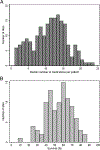Medications and in-hospital outcomes in infants born at 22-24 weeks of gestation
- PMID: 32066843
- PMCID: PMC7293630
- DOI: 10.1038/s41372-020-0614-4
Medications and in-hospital outcomes in infants born at 22-24 weeks of gestation
Abstract
Objective: To evaluate the most commonly used medications and in-hospital morbidities and mortality in infants born 22-24 weeks of gestation.
Study design: Multicenter retrospective cohort study of infants born 22-24 weeks of gestation (2006-2016), without major congenital anomalies and with available medication data obtained from neonatal intensive care units managed by the Pediatrix Medical Group.
Results: This study included 7578 infants from 195 sites. Median (25th, 75th percentile): birthweight was 610 g (540, 680); the number of distinct medications used was 13 (8, 18); and different antimicrobial exposure was 4 (2, 5). The most common morbidities were BPD (41%) and grade III or IV IVH (20%), and overall survival varied from 46% (2006) to 57% (2016).
Conclusions: A large number of medications were used in periviable infants. There was a high prevalence of in-hospital morbidities, and survival of this population increased over the study period.
Conflict of interest statement
Figures


Similar articles
-
Trends in Resources for Neonatal Intensive Care at Delivery Hospitals for Infants Born Younger Than 30 Weeks' Gestation, 2009-2020.JAMA Netw Open. 2023 May 1;6(5):e2312107. doi: 10.1001/jamanetworkopen.2023.12107. JAMA Netw Open. 2023. PMID: 37145593 Free PMC article.
-
Trends in morbidities of late preterm infants in the neonatal intensive care unit.J Perinatol. 2023 Nov;43(11):1379-1384. doi: 10.1038/s41372-023-01705-5. Epub 2023 Jul 1. J Perinatol. 2023. PMID: 37393396
-
The clinical burden of extremely preterm birth in a large medical records database in the United States: complications, medication use, and healthcare resource utilization.J Matern Fetal Neonatal Med. 2022 Dec;35(26):10271-10278. doi: 10.1080/14767058.2022.2122035. Epub 2022 Sep 28. J Matern Fetal Neonatal Med. 2022. PMID: 36170979
-
Hospital variation and risk factors for bronchopulmonary dysplasia in a population-based cohort.JAMA Pediatr. 2015 Feb;169(2):e143676. doi: 10.1001/jamapediatrics.2014.3676. Epub 2015 Feb 2. JAMA Pediatr. 2015. PMID: 25642906
-
Actuarial Survival Based on Gestational Age in Days at Birth for Infants Born at <26 Weeks of Gestation.J Pediatr. 2020 Oct;225:97-102.e3. doi: 10.1016/j.jpeds.2020.05.047. Epub 2020 May 28. J Pediatr. 2020. PMID: 32474028
Cited by
-
Drug utilisation in neonatal units in England and Wales: a national cohort study.Eur J Clin Pharmacol. 2022 Apr;78(4):669-677. doi: 10.1007/s00228-021-03267-x. Epub 2022 Jan 13. Eur J Clin Pharmacol. 2022. PMID: 35028673 Free PMC article.
-
Respiratory, growth, and survival outcomes of infants with tracheostomy and ventilator dependence.Pediatr Res. 2021 Aug;90(2):381-389. doi: 10.1038/s41390-020-01183-x. Epub 2020 Oct 3. Pediatr Res. 2021. PMID: 33010793 Free PMC article.
-
Improved Survival of Periviable Infants after Alteration of the Threshold of Viability by the Neonatal Resuscitation Program 2015.Children (Basel). 2021 Jan 4;8(1):23. doi: 10.3390/children8010023. Children (Basel). 2021. PMID: 33406755 Free PMC article.
-
An Immature Science: Intensive Care for Infants Born at ≤23 Weeks of Gestation.J Pediatr. 2021 Jun;233:16-25.e1. doi: 10.1016/j.jpeds.2021.03.006. Epub 2021 Mar 7. J Pediatr. 2021. PMID: 33691163 Free PMC article. Review. No abstract available.
-
Survival outcomes among periviable infants: a systematic review and meta-analysis comparing different income countries and time periods.Front Public Health. 2024 Dec 30;12:1454433. doi: 10.3389/fpubh.2024.1454433. eCollection 2024. Front Public Health. 2024. PMID: 39807383 Free PMC article.
References
-
- Ecker JL, Kaimal A, Mercer BM, Blackwell SC, deRegnier RA. American College of Obstetricians and Gynecologists and the Society for Maternal–Fetal Medicine, et al. Periviable birth: interim update. Am J Obstet Gynecol. 2016;215:B2–B12.e1. - PubMed
-
- Raju TN, Mercer BM, Burchfield DJ, Joseph GF. Periviable birth: executive summary of a joint workshop by the Eunice Kennedy Shriver National Institute of Child Health and Human Development, Society for Maternal-Fetal Medicine, American Academy of Pediatrics, and American College of Obstetricians and Gynecologists. J Perinatol. 2014;34:333–42. - PubMed
-
- Mercer BM. Periviable birth and the shifting limit of biability. Clin Perinatol. 2017;44:283–6. - PubMed
Publication types
MeSH terms
Grants and funding
LinkOut - more resources
Full Text Sources
Medical

